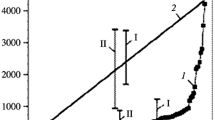Summary
Measurements of the number of condensation nuclei have been carried out with the photo-electric automatic nucleus counter of F. Verzár at Locarno-Monti on the Southern slope of the Alps. The records of one year have been elaborated with respect to the so called sunrise effect. There is a very strong significance for this phenomenon. It seems that a sunset effect does not exist.
Résumé
Utilisant le compteur photoélectrique automatique des noyaux de condensation de F. Verzár, l'on a mesuré le nombre des noyaux de condensation à Locarno-Monti, au versant sud des Alpes. L'energistrement d'une année a été étudié en relation avec l'effet du lever du soleil. Le phénomène en question semble clairement établi, mais un effet correspondant au coucher du soleil ne peut être mis en évidence.
Zusammenfassung
Mit dem automatischen photoelektrischen Kondensationskernzähler nach F. Verzár wurden in Locarno-Monti am Alpensüdhang Messungen der Kondensationskernkonzentration ausgeführt. Die Registrierungen eines Jahres wurden auf den sogenannten Sonnenaufgangseffekt hin untersucht. Es zeigte sich, dass diese Erscheinung statistisch stark gesichert ist. Ein Sonnenuntergangseffekt scheint aber nicht zu existieren.
Similar content being viewed by others
Literatur
Proceedings of the Fourth International Symposium on Condensation Nuclei, Frankfurt-Main & Heidelberg, 1961. Geofisica pura e applicata, Vol. 50 (1961/III).
Pollak L. W. &A. L. Metnieks:The influence of pressure and temperature on the counting of condensation nuclei, Geofisica pura e applicata, Vol. 50, pp. 7–22 (1961).
Verzár F.:Kondensationskernzähler mit automatischer Registrierung. Archiv für Meteorologie, Geophysik und Bioklimatologie, Serie A, Bd. V. S. 372–376 (1953).
Bitterli H. &F. Verzár:Erfahrungen mit dem automatischen Kondensationskernzähler. Archiv für Meteorologie, Geophysik und Bioklimatologie, Serie A. Bd. 6, S. 211–217 (1954).
Thams J. C. &W. Wieland:Die Wirbelbildung im kleinen Scholzschen Kondensationskernzähler, Geofisica pura e applicata, Vol. XX, S. 138–156 (1951).
Metnieks A. L.:On F. Verzár's Photo-Electric Automatic Nucleus Counter, Geofisica pura e applicata, Vol. 36, pp. 41–48 (1957).
Ackermann P., M. Bider &F. Verzár:Kontinuierliche Messungen von atmosphärischen Kondensationskernen, Geofisica pura e applicata, Vol. 29, S. 167–200 (1954).
Israël H.:Atmosphärische Elektrizität, Teil 1, Leipzig 1957.
Brooks C. E. P. & N. Carruthers:Handbook of Statistical Methods in Meteorology, London 1953.
Fisher R. A. & F. Yates:Statistical Tables, London 1957.
Siksna R.:On the Condensation Nuclei about the time of Sunrise, Geofisica pura e applicata, Vol. 36, pp. 104–109 (1957).
Author information
Authors and Affiliations
Rights and permissions
About this article
Cite this article
Müller, W., Thams, J.C. Zum Problem des Sonnenaufgangseffektes der Kondensationskerne. Geofisica Pura e Applicata 52, 214–226 (1962). https://doi.org/10.1007/BF01996013
Received:
Issue Date:
DOI: https://doi.org/10.1007/BF01996013




